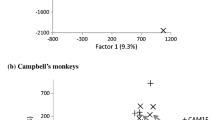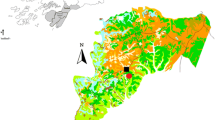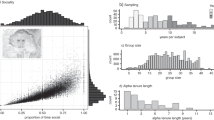Abstract
Intergroup variation in social networks can have important implications for inferring the evolution of primate social relationships, but the underpinnings of this variation remain poorly understood. To further our understanding of this topic, we investigated whether intergroup variation in colobus grooming networks was associated with group size, the proportion of female kin and infants, and stability in female group composition. Between 2008 and 2009, we collected behavioral data via focal sampling of 61 females in 8 groups at Boabeng-Fiema, Ghana, which we used to calculate grooming network metrics. We collected demographic data during the same time period to determine group sizes and group compositions, while we used longitudinal data (2000–2009) to estimate stability in group composition. We determined kinship via partial pedigrees and genetic data from 17 short tandem repeat loci. Females in larger groups had more grooming partners but did not form weaker networks than females in smaller groups. This finding suggests that time constraints linked to large group sizes do not limit sociality in this population, which is similar to findings in other folivorous black-and-white colobus but contrasts with those in many frugivorous primates. Groups with a larger proportion of infants spent more time grooming, similar to some other mammals. Group stability correlated positively with centralization, i.e., inequity, for incoming ties. Networks were not affected by kin compositions of groups, in contrast to those in some female resident-nepotistic cercopithecines. We suggest that the relative importance of demographic factors in shaping social networks may vary between populations depending on diet and social structure.




Similar content being viewed by others
References
Altmann, J. (1974). Observational study of behaviour: Sampling methods. Behaviour, 49, 223–265.
Altmann, J. (1980). Baboon mothers and infants. Cambridge, MA: Harvard University Press.
Altmann, J., & Samuels, A. (1992). Costs of maternal-care: Infant-carrying in baboons. Behavioral Ecology and Sociobiology, 29, 391–398.
Bădescu, I., Sicotte, P., Ting, N., & Wikberg, E. C. (2014). Female parity, maternal kinship, infant age and sex influence natal attraction and infant handling in a wild colobine (Colobus vellerosus). American Journal of Primatology. doi:10.1002/ajp.22353.
Bergstrom, M. L., & Fedigan, L. M. (2013). Dominance style of female white-faced capuchins. American Journal of Physical Anthropology, 150, 591–601.
Berman, C. M., & Kapsalis, E. (2012). Variation over time in grooming kin bias among Cayo Santiago rhesus macaques supports time constraints. In: Q. Wang (Ed.), The Rhesus Macaques in Cayo Santiago and beyond: Bones, Genetics, and Behavior (pp. 227–245). New York: Springer.
Berman, C. M., Ogawa, H., Ionica, C., Yin, H., & Li, J. (2008). Variation in kin bias over time in a group of Tibetan macaques at Huangshan, China: Contest competition, time constraints or risk response? Behaviour, 145, 863–896.
Berman, C. M., Rasmussen, K. L. R., & Suomi, S. J. (1997). Group size, infant development and social networks in free-ranging rhesus monkeys. Animal Behaviour, 53, 405–421.
Berman, C. M., & Thierry, B. (2010). Variation in kin bias: Species differences and time constraints in macaques. Behaviour, 147, 1863–1887.
Borgatti, S. P., Everett, M. G., & Freeman, L. C. (2002). Ucinet for Windows: Software for social network analysis. Harvard: Analytic Technologies.
Brent, L. J. N., Lehmann, J., & Ramos-Fernandez, G. (2011). Social network analysis in the study of nonhuman primates: A historical perspective. American Journal of Primatology, 73, 720–730.
Brent, L. J. N., MacLarnon, A., Platt, M. J., & Semple, S. (2013). Seasonal changes in the structure of rhesus macaque social networks. Behavioral Ecology and Sociobiology, 67, 349–359.
Brent, L. J. N., Teichroeb, J. A., & Sicotte, P. (2008). Preliminary assessment of natal attraction and infant handling in wild Colobus vellerosus. American Journal of Primatology, 70, 101–105.
Cameron, E. Z., Setsaas, T. H., & Linklater, W. L. (2009). Social bonds between unrelated females increase reproductive success in feral horses. Proceedings of the National Academy of Sciences of the USA, 106, 13850–13853.
Champely, S. (2012). pwr: Basic functions for power analysis. http://CRAN.R-project.org/package=pwr (Accessed September 1, 2014).
Colin, J. (1992). Statistical power analysis. Current Directions in Psychological Science, 1, 98–101.
Croft, D., James, R., & Krause, J. (2008). Exploring animal social networks. Princeton, NJ: Princeton University Press.
Dasilva, G. L. (1992). The western black-and-whtie colobus as a low-energy stategist: Activity budgets, energy-expenditure, and energy-intake. Journal of Animal Ecology, 61, 79–91.
Di Fiore, A., & Rendall, D. (1994). Evolution of social organization: A reappraisal for primates by using phylogenetic methods. Proceedings of the National Academy of Sciences of the USA, 91, 9941–9945.
Dunbar, R. I. M. (1991). Functional significance of social grooming in primates. Folia Primatologica, 57, 121–131.
Durant, S. M., Kelly, M., & Caro, T. M. (2004). Factors affecting life and death in Serengeti cheetahs: Environment, age, and sociality. Behavioral Ecology, 15, 11–22.
Fashing, P. J. (2011). African colobine monkeys: Their behavior, ecology, and conservation. In C. Campbell, A. Fuentes, K. MacKinnon, S. Bearder, & R. Stumpf (Eds.), Primates in perspective (pp. 201–224). Oxford: Oxford University Press.
Flack, J. C., Girvan, M., de Waal, F. B. M., & Krakauer, D. C. (2006). Policing stabilizes construction of social niches in primates. Nature, 439, 426–429.
Forster, S., & Cords, M. (2005). Socialization of infant blue monkeys (Cercopithecus mitis stuhlmanni): Allomaternal interactions and sex differences. Behaviour, 142, 869–896.
Frank, R. E., & Silk, J. B. (2009). Grooming exchange between mothers and non-mothers: The price of natal attraction in wild baboons (Papio anubis). Behaviour, 146, 889–906.
Fruteau, C., van de Waal, E., van Damme, E., & Noe, R. (2011). Infant access and handling in sooty mangabeys and vervet monkeys. Animal Behaviour, 81, 153–161.
Gero, S., Gordon, J., & Whitehead, H. (2013). Calves as social hubs: Dynamics of the social network within sperm whale units. Proceedings of the Royal Society Biological Sciences B: Biological Sciences, 280, 1–9.
Guan, Z.-H., Huang, B., Ning, W.-H., Ni, Q.-Y., & Jiang, X.-L. (2013a). Proximity association in polygynous western black crested gibbons (Nomascus concolor jingdongensis): Network structure and seasonality. Zoological Research, 34, E1–E8.
Guan, Z.-H., Huang, B., Ning, W.-H., Ni, Q.-Y., Sun, G.-Z., & Jiang, X.-L. (2013b). Significance of grooming behavior in two polygynous groups of western black crested gibbons: Implications for understanding social relationships among immigrant and resident group members. American Journal of Primatology, 75, 1165–1173.
Gumert, M. D. (2007). Grooming and infant handling interchange in Macaca fascicularis: The relationship between infant supply and grooming payment. International Journal of Primatology, 28, 1059–1074.
Hall, J. B., & Swaine, M. D. (1981). Distribution and ecology of vascular plants in a tropical rain forest. Forest vegetation in Ghana. The Hague: Junk.
Hanneman, R. A., & Riddle, M. (2005). Introduction to social network methods. Riverside: University of California, Riverside.
Henzi, S. P., & Barrett, L. (2002). Infants as a commodity in a baboon market. Animal Behaviour, 63, 915–921.
Henzi, S. P., Lycett, J. E., & Weingrill, T. (1997). Cohort size and the allocation of social effort by female mountain baboons. Animal Behaviour, 54, 1235–1243.
Hinde, R. A. (1976). Interactions, relationships and social structure. Man, 11, 1–17.
Hrdy, S. (1976). Care and exploitation of nonhuman primate infants by conspecifics other than the mother. Advances in the Study of Behavior, 6, 101–158.
Idani, G. (1991). Social relationships between immigrant and resident bonobo (Pan paniscus) females at Wamba. Folia Primatologica, 57, 83–95.
Ilany, A., Barocas, A., Koren, L., Kam, M., & Geffen, E. (2013). Structural balance in the social networks of a wild mammal. Animal Behaviour, 85, 1397–1405.
Jacoby, D. M. P., Busawon, D. S., & Sims, D. W. (2010). Sex and social networking: The influence of male presence on social structure of female shark groups. Behavioral Ecology, 21, 808–818.
James, R., Croft, D. P., & Krause, J. (2009). Potential banana skins in animal social network analysis. Behavioral Ecology and Sociobiology, 63, 989–997.
Kalinowski, S. T., Taper, M. L., & Marshall, T. C. (2007). Revising how the computer program CERVUS accommodates genotyping error increases success in paternity assignment. Molecular Ecology, 16, 1099–1106.
Kapsalis, E. (2004). Matrilineal kinship and primate behavior. In B. Chapais & C. M. Berman (Eds.), Kinship and behavior in primates (pp. 153–176). Oxford: Oxford University Press.
Kasper, C., & Voelkl, B. (2009). A social network analysis of primate groups. Primates, 50, 343–356.
Kim, S. (2012). ppcor: Partial and semi-partial (part) correlation. R package version 1.0. http://CRAN.R-project.org/package=ppcor (Accessed June 1, 2014).
Koenig, B. (1994). Components of lifetime reproductive success in communally and solitarily nursing house mice: A laboratory study. Behavioral Ecology and Sociobiology, 34, 275–283.
Lambert, J. E. (1998). Primate digestion: Interactions among anatomy, physiology, and feeding ecology. Evolutionary Anthropology, 7, 8–20.
Lambin, X., & Yoccoz, N. G. (1998). The impact of population kin-structure on nestling survival in Townsend's voles, Microtus townsendii. Journal of Animal Ecology, 67, 1–16.
Langergraber, K., Mitani, J., & Vigilant, L. (2009). Kinship and social bonds in female chimpanzees (Pan troglodytes). American Journal of Primatology, 71, 840–851.
Lehmann, J., & Boesch, C. (2009). Sociality of the dispersing sex: The nature of social bonds in West African female chimpanzees, Pan troglodytes. Animal Behaviour, 77, 377–387.
Lehmann, J., Korstjens, A. H., & Dunbar, R. I. M. (2007). Group size, grooming and social cohesion in primates. Animal Behaviour, 74, 1617–1629.
Lusseau, D., & Newman, M. E. J. (2004). Identifying the role that animals play in their social networks. Proceedings of the Royal Society of London B: Biological Sciences, 271, S477–S481.
Madden, J. R., Drewe, J. A., Pearce, G. P., & Clutton-Brock, T. H. (2009). The social network structure of a wild meerkat population: 2. Intragroup interactions. Behavioral Ecology and Sociobiology, 64, 81–95.
Marshall, T. C., Slate, J., Kruuk, L. E. B., & Pemberton, J. M. (1998). Statistical confidence for likelihood-based paternity inference in natural populations. Molecular Ecology, 7, 639–655.
McCowan, B., Anderson, K., Heagarty, A., & Cameron, A. (2008). Utility of social network analysis for primate behavioral management and well-being. Applied Animal Behaviour Science, 109, 396–405.
Moses, R. A., & Millar, J. S. (1994). Philopatry and mother-daughter associations in bushy-tailed woodrats: Space use and reproductive success. Behavioral Ecology and Sociobiology, 35, 131–140.
Nakagawa, S. (2004). A farewell to Bonferroni: The problems of low statistical power and publication bias. Behavioral Ecology, 15, 1044–1045.
Oates, J. F. (1977). The social life of a black-and-white colobus monkey, Colobus guereza. Zeitschrift fuer Tierpsychologie, 45, 1–60.
Olson, L. E., & Blumstein, D. T. (2009). A trait-based approach to understand the evolution of complex coalitions in male mammals. Behavioral Ecology, 20, 624–632.
Perry, S., Manson, J., Muniz, L., Gros-Louis, J., & Vigilant, L. (2008). Kin-biased social behaviour in wild adult female white-faced capuchins, Cebus capucinus. Animal Behaviour, 76, 187–199.
Pinter-Wollman, N., Hobson, E. A., Smith, J. E., Edelman, A. J., Shizuka, D., de Silva, S., Waters, J. S., Prager, S. D., Sasaki, T., Wittemyer, G., et al. (2014). The dynamics of animal social networks: Analytical, conceptual, and theoretical advances. Behavioral Ecology, 25, 242–255.
R Core Team. (2014). R: A language and environment for statistical computingR Foundation for Statistical Computing. http://www.R-project.org (Accessed May 28, 2014).
Rendall, D., & Di Fiore, A. (1995). The road less traveled: Phylogenetic perspectives in primatology. Evolutionary Anthropology, 4, 43–52.
Rendall, D., & Di Fiore, A. (2007). Homoplasy, homology, and the perceived special status of behavior in evolution. Journal of Human Evolution, 52, 504–521.
Ruan, H., & Wu, C.-F. (2008). Social interaction-mediated lifespan extension of Drosophila Cu/Zn superoxide dismutase mutants. Proceedings of the National Academy of Sciences of the USA, 105, 7506–7510.
Saj, T. L., Marteinson, S., Chapman, C. A., & Sicotte, P. (2007). Controversy over the application of current socioecological models to folivorous primates: Colobus vellerosus fits the predictions. American Journal of Physical Anthropology, 133, 994–1003.
Schel, A. M., Rawlings, B., Claidiere, N., Wilke, C., Wathan, J., Richardson, J., Pearson, S., Herrelko, E. S., Whiten, A., & Slocombe, K. (2013). Network analysis of social changes in a captive chimpanzee community following the successful integration of two adult groups. American Journal of Primatology, 75, 254–266.
Seyfarth, R. M. (1977). A model of social grooming among adult female monkeys. Journal of Theoretical Biology, 65, 671–698.
Seyfarth, R. M., & Cheney, D. L. (2012). The evolutionary origins of friendship. Annual Review of Psychology, 63, 153–177.
Silk, J. B., Alberts, S. C., & Altmann, J. (2003). Social bonds of female baboons enhance infant survival. Science, 302, 1231–1234.
Silk, J. B., Beehner, J. C., Bergman, T. J., Crockford, C., Engh, A. L., Moscovice, L. R., Wittig, R. M., Seyfarth, R. M., & Cheney, D. L. (2009). The benefits of social capital: Close social bonds among female baboons enhance offspring survival. Proceedings of the Royal Society B: Biological Sciences, 276, 3099–3104.
Silk, J. B., Beehner, J. C., Bergman, T. J., Crockford, C., Engh, A. L., Moscovice, L. R., Wittig, R. M., Seyfarth, R. M., & Cheney, D. L. (2010). Strong and consistent social bonds enhance the longevity of female baboons. Current Biology, 20, 1359–1361.
Stanley, C. R., & Dunbar, R. I. M. (2013). Consistent social structure and optimal clique size revealed by social network analysis of feral goats, Capra hircus. Animal Behaviour, 85, 771–779.
Sterck, E. H. M., Watts, D. P., & van Schaik, C. P. (1997). The evolution of female social relationships in nonhuman primates. Behavioral Ecology and Sociobiology, 41, 291–309.
Strier, K. (1994). Myth of the typical primate. Yearbook of Physical Anthropology, 37, 233–271.
Sueur, C., Petit, O., De Marco, A., Jacobs, A. T., Watanabe, K., & Thierry, B. (2011). A comparative network analysis of social style in macaques. Animal Behaviour, 82, 845–852.
Teichroeb, J. A., Saj, T. L., Paterson, J. D., & Sicotte, P. (2003). Effect of group size on activity budgets of Colobus vellerosus in Ghana. International Journal of Primatology, 24, 743–758.
Teichroeb, J. A., & Sicotte, P. (2009). Test of the ecological-constraints model on ursine colobus monkeys (Colobus vellerosus) in Ghana. American Journal of Primatology, 71, 49–59.
Teichroeb, J. A., Wikberg, E. C., & Sicotte, P. (2009). Female dispersal patterns in six groups of ursine colobus (Colobus vellerosus): Infanticide avoidance is important. Behaviour, 146, 551–582.
Tiddi, B., Aureli, F., & Schino, G. (2010). Grooming for infant handling in tufted capuchin monkeys: A reappraisal of the primate infant market. Animal Behaviour, 79, 1115–1123.
van Schaik, C. P. (1989). The ecology of social relationships amongst female primates. In V. Standen & R. Foley (Eds.), Comparative socioecology: The behavioral ecology of humans and other mammals (pp. 195–218). Oxford: Blackwell Scientific.
Wang, J. (2011). COANCESTRY: A program for simulating, estimating and analysing relatedness and inbreeding coefficients. Molecular Ecology Resources, 11, 141–145.
Watts, D. (1991). Harassment of immigrant female mountain gorillas by resident females. Ethology, 89, 135–153.
Watts, D. P. (2000). Grooming between male chimpanzees at Ngogo. Kibale National Park. II. Influence of male rank and possible competition for partners. International Journal of Primatology, 21, 211–238.
Wey, T. W., & Blumstein, D. T. (2010). Social cohesion in yellow-bellied marmots is established through age and kin structuring. Animal Behaviour, 79, 1343–1352.
Wey, T. W., Burger, J. R., Ebensperger, L. A., & Hayes, L. D. (2013). Reproductive correlates of social network variation in plurally breeding degus (Octodon degus). Animal Behaviour, 85, 1407–1414.
Whitehead, H., & Kahn, B. (1992). Temporal and geographic variation in the the social structure of female sperm whales. Canadian Journal of Zoology–Revue Canadienne De Zoologie, 70, 2145–2149.
Wikberg, E. (2012). Relationships, relatedness, and residency patterns in female Colobus vellerosus. Ph.D. dissertation: University of Calgary.
Wikberg, E. C., Sicotte, P., Campos, F. A., & Ting, N. (2012). Between-group variation in female dispersal, kin composition of groups, and proximity patterns in a black-and-white colobus monkey (Colobus vellerosus). PLoS ONE, 7, e48740.
Wikberg, E. C., Teichroeb, J. A., Bădescu, I., & Sicotte, P. (2013). Individualistic female dominance hierarchies with varying strength in a highly folivorous population of black-and-white colobus. Behaviour, 150, 295–320.
Wikberg, E. C., Ting, N., & Sicotte, P. (2014a). Familiarity is more important than phenotypic similarity in shaping social relationships in a facultative female dispersed primate, Colobus vellerosus. Behavioural Processes, 106, 27–35.
Wikberg, E. C., Ting, N., & Sicotte, P. (2014b). Kinship and similarity in residency status structure female social networks in black-and-white colobus monkeys (Colobus vellerosus). Americal Journal of Physical Anthropology, 153, 365–376.
Wong, S. N. P., & Sicotte, P. (2006). Population size and density of Colobus vellerosus at the Boabeng-Fiema Monkey Sanctuary and surrounding forest fragments in Ghana. American Journal of Primatology, 68, 465–476.
Wrangham, R. W. (1980). An ecological model of female-bonded primate groups. Behaviour, 75, 262–300.
Acknowledgments
We thank Fernando Campos and Teresa Holmes for their research assistance. We also thank the anonymous reviewers and the editors for their helpful comments on the manuscript. The following agencies funded our research: Alberta Innovates Technology Futures (formerly Alberta Ingenuity), American Society of Primatologists, International Primatological Society, Leakey Foundation, Natural Sciences and Engineering Research Council of Canada, Sweden-America Foundation, Wenner-Gren Foundation, and the University of Calgary.
Author information
Authors and Affiliations
Corresponding author
Rights and permissions
About this article
Cite this article
Wikberg, E.C., Ting, N. & Sicotte, P. Demographic Factors Are Associated with Intergroup Variation in the Grooming Networks of Female Colobus (Colobus vellerosus). Int J Primatol 36, 124–142 (2015). https://doi.org/10.1007/s10764-015-9816-6
Received:
Accepted:
Published:
Issue Date:
DOI: https://doi.org/10.1007/s10764-015-9816-6




